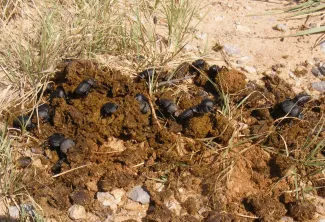It’s hard to imagine anyone or anything searching far and wide for good poop, but that’s just what dung beetles do. And not just any dung will do, they seek to find the best.
The first question ‘fresh’ on our mind may be how or why dung beetles are creatures worthy of our management efforts. After all, the role of managing manure isn’t the most glamorous. But dung beetles are ecosystem managers. In essence, they are the kings and queens of dung removal. They also rework soils, aiding in soil aeration, enrichment, biodiversity, and water infiltration. Dung beetles play a key role in pest suppression, breaking down manure piles quickly which reduces the conditions required for flies and parasites to complete their lifecycle. Dung beetles also play a role in the quick regeneration of plant growth for forage and cover, and they are a source of food for many other animals including birds, mammals, reptiles, amphibians, and even other insects. Like nearly all organisms in nature, dung beetles are just another important piece of the puzzle within and among the healthy habitats and ecosystems we try to manage for.

Of course, there is a second, if not more common, question that quickly comes to mind when thinking about dung beetles and that is, “why are they so fascinated with dung?” It’s an interesting question for sure, and to understand the dung beetle we must understand the dung.
First, nearly all dung beetles are members of the scarab family of insects which boasts of 35,000 species of beetles worldwide. Of dung beetles, North America has about seven dozen species which can be found inhabiting farmland, forest, rangeland, pasture, prairie, and desert habitats. Most dung beetles are brown to black in color, but some can be metallic green. While most of their time is spent aground, dung beetles do have wings and can fly, sometimes covering several miles to find the right type of animal feces they need for food, family, and fun. Simply put, the dung piles they seek out and enjoy are the lifeline of food to their well-being now and the key to the future generations of dung beetle’s long term.
LIFE AT A DUNG PILE
Dung piles of herbivores and omnivores are the preferred choice for dung beetles, but not all dung will do. Piles must be relatively fresh, offering nutritious moisture and undigested bits of food for larvae and adults to enjoy. A dozen or more beetles are likely be to present at a single pile, and a chance encounter between a male and female allows the pair to form a bond. Often, the male offers a giant-sized brood ball to a nearby female and, if she accepts it, they roll it away together to a more suitable site for burying. However, not all dung beetles follow this traditional “dung ball” method. Others spend their time dwelling on top of or within the dung heap or tunneling through and underneath.
Regardless of the preferred method, each dung beetle has the goal of creating the perfect family home for raising new dung beetles. Dung ball rollers and tunnelers dig and bury their ball or dung mass below ground with females laying a single egg, sometimes more, within their hidden treasure. Female beetles that dwell on top of or within the pile simply lay eggs within the entire heap. Eventually, larvae hatch and enjoy the abundant food supply around them.
Overall, the life span of a dung beetle is about three years, depending on the species. The amazing thing about dung beetles is their strength as the dung balls and masses they move can be 50 times or more above the animal’s own weight. Sometimes these unique beetles are known as tumblebugs, referring to the tumbling they often do trying to maneuver their cumbersome balls of dung to that perfect location.
CONSERVATION AND MANAGEMENT
Managing for dung beetles may seem a little unconventional, if not perplexing. Even more, we’d have to search far and wide to find anyone putting on camouflage, wearing blaze orange, or slipping into some waders to hunt up a few dung beetles. But, as mentioned, dung beetles are simply a piece of the larger puzzle. In other words, managing for the benefit of dung beetles includes many of the same strategies that land managers employ when managing for healthy deer habitat, or species like quail or turkey.
In general, managing for healthy, diverse native plant communities through prescribed burning, strategic grazing, and sound forest and prairie management helps provide the year-round food and cover resources that white-tailed deer, wild turkey, Northern bobwhite and livestock require.
Pesticides remain a top threat to nearly all insect types, and dung beetles are especially vulnerable to insecticides, whether for farm, forest, range, or urban settings. Limiting pesticide use, following label precautions, and choosing products and methods that minimize the risks to wildlife are vital for pollinating insects and species like dung beetles that greatly benefit the habitats and resources we try to sustainably manage for.
So, observing an inverted beetle maneuvering a dung ball with excitement and determination is a good thing. We may question their lifestyle, but their presence can remind us of the great benefits sound wildlife habitat management can have for the species we enjoy seeing.